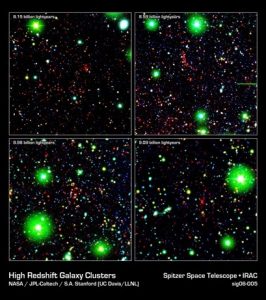The work of the UMKC Galaxy Evolution Group is regularly featured in the national and international press.
IDCS J1426.5+3508: NASA’s Great Observatories Weigh Massive Young Galaxy Cluster
The galaxy cluster IDCS J1426.5+3508, the rare, massive, distant cluster discovered in 2012 (see press release below), has recently been studied in great detail by NASA’s Great Observatories. Following its discovery with the Spitzer Space Telescope, its extreme distance of 10 billion light years was measured using the Keck Observatory and the Hubble Space Telescope (the latter also discovered its gravitational arc). Its mass, previously measured using the CARMA radio array, was confirmed and improved using new observations from the Chandra X-ray Observatory. This new work, by UMKC astronomer Mark Brodwin, measured a robust mass of over 400 trillion solar masses consistently from several independent techniques. The observations also showed that the cluster has a “cool core”, a clump of dense, cool X-ray emitting gas indicative of an evolved, relaxed cluster. This is the most distant known cool core cluster, suggesting it was one of the earliest massive structures to form after the Big Bang.
Read more about it in the NASA press release. The journal article describing this record-breaking result is here.

Whopping Galaxy Cluster Spotted with Help of NASA Telescopes
The Massive and Distance Clusters of WISE Survey (MaDCoWS) is the first all-sky search for galaxy clusters at redshift beyond z ≳ 1, when the Universe was less than half its present size. It uses data from the Wide-field Infrared Survey Explorer (WISE), a NASA satellite that mapped the entire sky in several infrared filters. Those wavelengths are particularly powerful for finding very distant massive galaxies — the kind that live in huge clusters of galaxies. As the first survey sensitive to such distant structures over the whole sky, MaDCoWS is discovering some of the most massive clusters ever found in that era. An example is called Massive Overdense Object (MOO) J1142+1527, located 8.5 billion light years away. UMKC astronomer Mark Brodwin used a radio telescope in California called CARMA to determine its mass by measuring the strength of the shadow it cast on the cosmic microwave background. The result is astounding — it has a mass greater than a quadrillion (that is, a million billion) Suns.
Read more about it in the NASA press release. The journal articles describing this result and the MaDCoWS survey more fully are here, here and here.
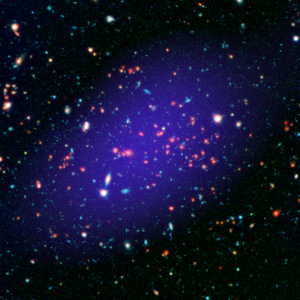
The Rise and Fall of Galactic Cities
In a major new study led by UMKC astronomer Mark Brodwin, the last growth spurt of distant, massive galaxy clusters was identified about 9 billion years in the past (at redshift z~1.4). Although galaxy clusters today are basically dead, with no ongoing star formation, their galaxies must have been assembled at some point in the past. Brodwin and collaborators used the infrared vision of the Spitzer Space Telescope to directly probe the star formation activity in the largest sample of distant galaxy clusters to date, effectively seeing them as they were between 7.5 and 9 billion years in the past. They discovered that the galaxies in these clusters — a well-studied subset of the IRAC Shallow Cluster Survey — were rapidly forming stars, dozens and even hundreds of times as fast as occurs in our own Milky Way. The star formation begins to be rapidly quenched, likely due to AGN feedback, soon after this newly discovered “fireworks” epoch.
A related study led, by collaborator Stacey Alberts of the University of Massachusetts at Amherst, confirmed this important result using data from the Herschel Space Observatory. These studies have at last identified the long-sought era of star formation in galaxy clusters.
Read more about it in the NASA press release. The journal articles describing the results more fully are here and here.
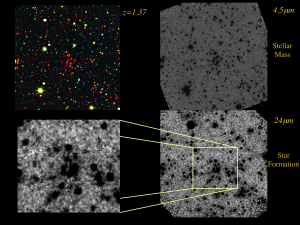
UMKC Astronomer Selected to Join Euclid Consortium
The European Space Agency has selected Mark Brodwin, University of Missouri-Kansas City assistant professor of physics and astronomy, to be one of only 43 NASA-nominated science team members to participate in its Euclid mission. Euclid is a major new space telescope being designed specifically to study the nature of dark energy, which is responsible for causing the expansion of the Universe to accelerate — an observation that earned the Nobel Prize in Physics in 2011. Euclid will launch in 2020 and spend six years mapping the locations and measuring the shapes of as many as 2 billion galaxies spread over more than one-third of the sky. It will also discover tens of thousands of galaxy clusters out to z~2, test general relativity and measure the masses of neutrinos. Read the press release for a high-level overview. For more detailed information on Euclid, read the Red Book, which specifies the mission requirements and goals.
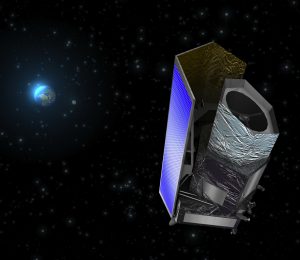
Most Massive, Distant Cluster Ever Found — With a Mystery Arc!
Galaxy Cluster IDCS J1426.5+3508 is an extremely rare, massive, distant galaxy cluster discovered with the Spitzer Space Telescope by UMKC astronomer Mark Brodwin. Its distance of about 10 billion light years (z=1.75) was measured using the Hubble Space Telescope (HST), with a little help from the W. M. Keck Telescope in Hawaii. The very large mass, about 400 trillion times the mass of our Sun, was measured using Combined Array for Research in mm-Wave Astronomy (CARMA) via the Sunyaev-Zel’dovich (SZ) Effect. This is by far the most distant SZ detection to date. This massive cluster shares an evolutionary path with the most massive clusters observed at all later epochs. Most bizarrely, it is strongly lensing a more distant galaxy. This is notexpected to occur in our current cosmological model, so it’s a bit of a mystery. Deeper follow-up HST and Chandra observations are underway… stay tuned!
Read more about it in the NASA press release. The related journal articles are here, here, and here. Covered in the popular press by NBC News, Wired, and many others.

Discovery of the Most Distant Galaxy Cluster Ever Found With the Sunyaev-Zel’dovich Effect
Galaxy cluster SPT-CL J0546-5345, at z=1.067, was found in the South Pole Telescope Survey by looking for the shadow it casts on the Cosmic Microwave Background radiation. Not only are we seeing it when the Universe was less than half its present age, but it’s also among the most massive ever found at that great distance. Read more about it in the press release, or download the full paper from the Astrophysical Journal or the arXiv preprint server.
This discovery achieved extensive national and international press coverage by major news organizations (CBS News, MSNBC), popular science media (Astronomy Magazine, Discover Channel, Space.com, Universe Today), general interest news aggregators (Yahoo!, UPI, Wired, Gizmodo), and dozens of news sites throughout the world (Daily India, St. Louis Globe-Democrat, Malaysia Sun, Milwaukee Journal Sentinel, OneIndia, Albequerque Express, FARS news [Iran], La Tercera [Chile], Popular Mechanics [Russia], EuropaPress [Spain], etc…).
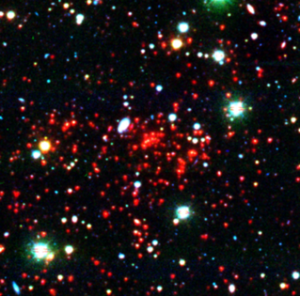
First Measurement of Ancient Cosmic Urban Sprawl
In this work, the clustering signal from hundreds of distant galaxy clusters was measured in the IRAC Shallow Cluster Survey (ISCS). This first measurement of the clustering strength at redshift unity, when the Universe was half its present age, confirmed the predictions from the current structure formation paradigm. In addition, this work provided evidence of an evolutionary connection between galaxy clusters and the infrared-brightest, black-hole driven galaxies which were common at even earlier times. Read more about it in the Spitzer Science Center Featured Article, or download the full paper from the Astrophysical Journal Letters or the arXiv preprint server.
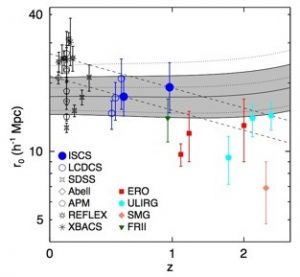
The IRAC Shallow Cluster Survey (ISCS)
The IRAC Shallow Cluster Survey (ISCS) was presented in a press release at the 208th meeting of the American Astronomical Society, in Calgary Canada in June 2006. Here’s an excerpt from the NASA summary of the event:
Astronomers Find Ancient ‘Cities’ of Galaxies
A team of astronomers using NASA’s Spitzer Space Telescope has discovered a grand total of nearly 300 clusters of galaxies. Almost 100 of these are as far as 8 to 10 billion light-years away, which means they date back to a time when our universe was less than one-third its present age. Galaxy clusters are the universe’s high-density environments, similar to cities on Earth. A single galaxy cluster can contain hundreds of galaxies like our own Milky Way. “At this distance, we are literally looking at these galaxies as they were over 8 billion years ago,” said Dr. Mark Brodwin of NASA’s Jet Propulsion Laboratory in Pasadena, Calif., who co-led the discovery. “It’s like being able to take a picture of Rome during the peak of the Roman Empire.”
Read more about the AAS press conference and the NASA press release accompanying this remarkable image. This work was featured in USA Today, Astronomy Magazine, Space.com and Universe Today, and was covered by dozens of press outlets from Florida to Germany.
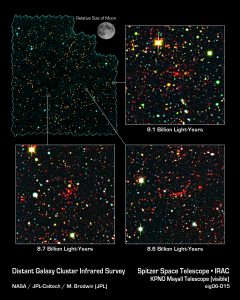
Spitzer Discovers Most Distant Galaxy Cluster
The Spitzer Science Center issued a press release reporting the discovery of the most distant galaxy cluster ever found, at redshift z=1.41, or a distance of about 9 billion light years. This cluster was found by combining shallow Spitzer/IRAC imaging with deep ground-based optical imaging. Using accurate photometric redshifts, a sort of poor man’s spectroscopy, a large sample of candidate galaxy clusters were identified in the Bootes constellation. Deep optical spectroscopy from the Keck telescopes in Hawaii confirmed that the first four candidates were in fact high redshift clusters of galaxies. This survey has since been named the IRAC Shallow Cluster Survey (ISCS), and is the most successful high redshift cluster survey — by any detection method — to date.
Read the Spitzer press release, and have a look at the pretty pictures JPL made for the occasion. The related journal articles are here, here, here and here. Covered in the popular press by Universe Today.
